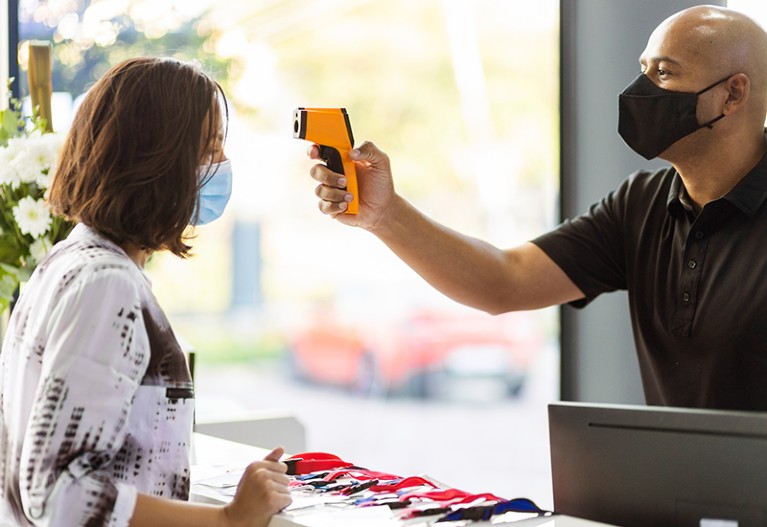
A receptionist checks the temperature of a conference attendee.Credit: Getty
Many scientific meetings are resuming after years of COVID-19 postponements and cancellations. Many people are eager to see old friends and colleagues again, to renew professional and personal networks, and to put the pandemic behind them. But, wishing the pandemic to be over does not make it so.
Earlier this year, I joined more than 100 colleagues for one week of scientific discussions and networking. For many of us, this was our first conference since the pandemic began. Masking was strictly enforced in the lecture theatre, but at mealtimes we were crammed together in a single, poorly ventilated space. These were textbook superspreader conditions.
Two days after the conference ended, I tested positive for COVID-19 and started hearing anecdotal reports that other attendees had also been infected. To find out how widespread these infections were, I put together an anonymous online survey and invited all the attendees to complete it. (I obtained their e-mail addresses through the conference’s online portal.) More than 80% responded. Within 10 days after the event, 28% of respondents came down with COVID-19 (all but 2 cases were confirmed by antigen or polymerase chain reaction (PCR) tests), and a further 11% reported getting sick with something else. These percentages are consistent with other accounts of attempts to assess infection rates after a conference.
Not all the COVID-19 cases following our conference should be attributed to the meeting itself, because, at the time, the rate of COVID-19 in the area was not zero. But it was also nowhere near 28%. Furthermore, some of the infections might have been acquired during travel to or from the conference, not during the meeting itself. Conversely, some studies suggest that up to 40% of COVID-19 infections might be asymptomatic (Q. Ma et al. JAMA Netw. Open 4, e2137257; 2021), so the actual infection rate might have been substantially higher than 28%.
We could have taken action to minimize the risk of infection — for example, by demanding outdoor dining options, forgoing the meals entirely, avoiding all unmasked indoor situations, or even skipping most or all of the conference — but we had no idea that the risks were so high.
The organizers hosted a series of similar conferences, and a colleague of mine who attended one of the first in this series told me that it, too, was followed by a big SARS-CoV-2 outbreak. The organizers could have made changes to better protect attendees, if they had known they had a problem in the first place. And they could have been aware of this issue simply by surveying recent attendees, as I did. It’s hard to understand why the organizers didn’t, and why other conference hosts don’t. Anonymous surveys are not rocket science, and many conference organizers already conduct post-meeting customer satisfaction surveys. So why don’t they make the effort to find out how many people are getting sick following such conferences? Perhaps it is because conference revenues sustain the finances of many scientific societies. Having said that, conference organizers shouldn’t be singled out: the risk of infection at many other types of event should also be better assessed.
Crucial data
This information is essential, not only so that individuals can make informed decisions about what risks they are willing to take, but also so that organizers can learn how effective their hygiene measures are, and take corrective action if necessary. If conference attendees knew the health risks they were going to be exposed to, everyone involved would have an incentive to do a better job of controlling them.
If meeting organizers are unwilling to assess the risks associated with their conferences as part of their post-event evaluations, what can attendees do? Guerilla actions such as mine are one option, but they require access to a list of meeting participants, which are often unavailable for large conferences. Another option would be for prospective attendees to collectively boycott meetings if the organizers are not willing to assess and disclose the infection rates.
If meeting hosts refuse to learn from their mistakes, each of us can at least learn from ours. I, for one, will be assuming that the risk of getting sick (with COVID-19 or something else) at any large meeting is roughly 20–40%, until I see data that convince me otherwise.


 The right mix: making a hybrid conference work for all
The right mix: making a hybrid conference work for all
 How I ran a virtual research retreat during a pandemic
How I ran a virtual research retreat during a pandemic
 Spare a thought for longitudinal diversity
Spare a thought for longitudinal diversity






